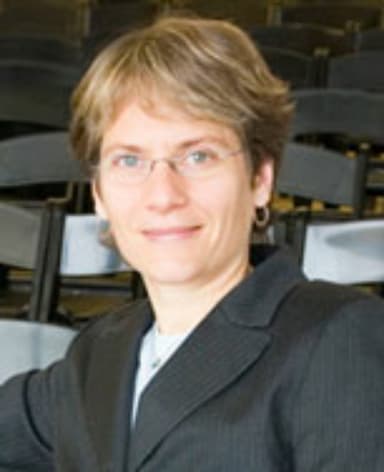New Field of Chemistry has Potential for Making Drugs Inside Patients -- And More

(Originally published by the American Chemical Society)
March 30, 2012
The traditional way of making medicines from ingredients mixed together in a factory may be joined by a new approach in which doctors administer the ingredients for a medicine separately to patients, and the ingredients combine to produce the medicine inside patients' bodies.

That's one promise from an emerging new field of chemistry, according to the scientist who founded it barely a decade ago. Carolyn Bertozzi, Ph.D., spoke on the topic — bioorthogonal chemistry — here today in delivering the latest Kavli Foundation Innovations in Chemistry Lecture at the 243rd National Meeting & Exposition of the American Chemical Society (ACS). More than 15,000 scientists and others are expected to attend the meeting, being held here through Thursday and featuring almost 12,000 reports on new developments in chemistry and related sciences.
Bertozzi explained that the techniques of bioorthogonal chemistry may fundamentally change the nature of drug development and diagnosis of disease, so that the active ingredients for medicines and substances to image diseased tissue are produced inside patients.
"Suppose a drug doesn't reach diseased tissue in concentrations high enough to work," Bertozzi said, citing one example of the potential of the new chemistry. "Maybe it is an oral drug that doesn't get absorbed very well into the blood through the stomach. You can imagine a scenario in which doctors administer two parts of the molecule that makes up the drug. The two units reach diseased tissue in large amounts or get absorbed through the stomach just fine. Then they recombine, producing the actual drug in the patient's body. Bioorthogonal chemistry is chemistry for life…literally!"
Bertozzi explained that bioorthogonal chemistry opens the door to creating new proteins, fats and sugars directly inside living cells without harming them. The field emerged from her frustration in the late 1990s with the lack of tools available to see sugars on the surfaces of living cells. Chains of these sugars, called glycans, sit on the surfaces of cells in the body and control the doorways through which different molecules enter. When a disease-causing virus enters and infects a cell, for instance, proteins on the virus's surface attach to certain glycans.
"To do that, we had to come up with a chemical reaction that would be really selective, only targeting the sugar of interest and the fluorescent probes that we delivered to it," said Bertozzi. The chemicals also couldn't stick to other biomolecules that the researchers didn't want to see.
That turned out to be a tall order, indeed. "We pulled all of our big textbooks off the shelves and flipped through them to see if there was something out there that fit our criteria," she said. Those criteria were essentially the conditions inside a living cell or living organism such as a mouse — a reaction that could occur in water at pH 7 and at 98.6 degrees Fahrenheit. The reaction also couldn't interfere with all the other biomolecules in a cell or organism that keep it alive.
"It was a pretty restrictive set of conditions that a traditionally trained organic chemist like me never had to work within," she explained. That's because these types of reactions are usually performed in very clean, dry test tubes and flasks under conditions that the chemist can control. A living cell or organism, with all its water, proteins, fats, sugars and metabolites is very messy and uncontrollable by comparison.
Bertozzi and her team at the University of California, Berkeley, went on to develop a slew of reactions that can add fluorescent labels to biomolecules.
Now, the field is exploding, with her group and others reporting new bioorthogonal chemical reactions every year that help researchers see sugars, fats, proteins, and even DNA and RNA, that can't be seen using conventional methods. Researchers currently use the reactions not only to see where a biomolecule is within a living cell or organism, but also to determine when a biomolecule is made and what it binds to. Researchers also are using the methods to add things besides labels, like drugs, to various biomolecules. Some of the chemicals used for the reactions are currently available separately or in kits.
Several of Bertozzi's reactions are patented, and some are licensed to companies, including Redwood Bioscience, a company she co-founded with David Rabuka, Ph.D. The company is focused on bringing this technology to the clinic.
A video on Bertozzi's work is available.
The scientists acknowledged funding from the National Institutes of Health and the Howard Hughes Medical Institute.
Sponsored by The Kavli Foundation, a philanthropic organization that supports basic scientific research, the lectures are designed to address the urgent need for vigorous, "outside the box" thinking by scientists as they tackle the world's mounting challenges, including climate change, emerging diseases, and water and energy shortages.
"We are dedicated to advancing science for the benefit of humanity, promoting public understanding of scientific research and supporting scientists and their work," said Kavli Foundation President Robert W. Conn in a statement. "The Kavli Foundation Innovations in Chemistry Lecture program at the ACS national meetings fits perfectly with our commitment to support groundbreaking discovery and promote public understanding."
The Kavli lectures debuted at the Anaheim meeting in March 2011 and will continue through 2013. They will address the urgent need for vigorous, new, "outside-the-box" thinking, as scientists tackle many of the world's mounting challenges like climate change, emerging diseases, and water and energy shortages. The Kavli Foundation, an internationally recognized philanthropic organization known for its support of basic scientific innovation, agreed to sponsor the lectures in conjunction with ACS in 2010.
The American Chemical Society is a non-profit organization chartered by the U.S. Congress. With more than 164,000 members, ACS is the world's largest scientific society and a global leader in providing access to chemistry-related research through its multiple databases, peer-reviewed journals and scientific conferences. Its main offices are in Washington, D.C., and Columbus, Ohio.